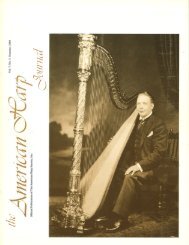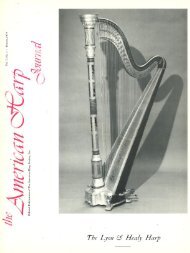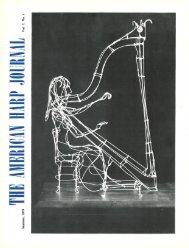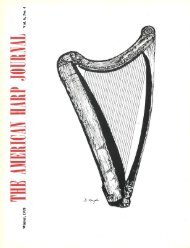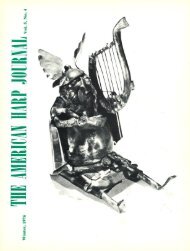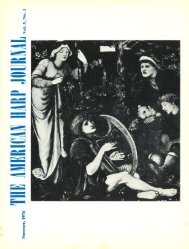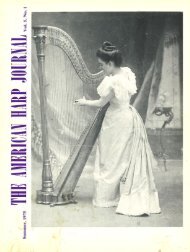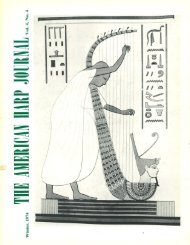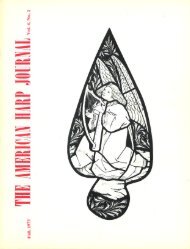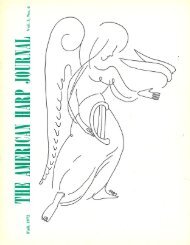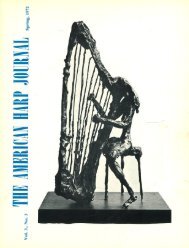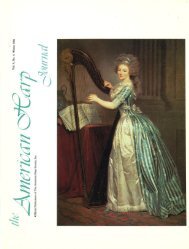You also want an ePaper? Increase the reach of your titles
YUMPU automatically turns print PDFs into web optimized ePapers that Google loves.
Nylon Strings<br />
A nylon string requires no special attention except<br />
that since it is rather slick, the holding knot will<br />
sometimes undo itself when you bring it to pitch.<br />
Doubling or tripling the safety loop seems to help.<br />
Also, since nylon stretches more than gut, pull the<br />
string quite taut (making sure it passes over the nut)<br />
before making any turns with the tuning key. This<br />
will prevent over-coiling on the pin.<br />
Although this article is aimed toward economy, I<br />
strongly advise maintaining good strings on your<br />
instrument. Don't allow your ear to become accustomed<br />
to false or dead strings.<br />
In the case of nylon strings you must watch for<br />
"pitting'' of the string which is created by the disc<br />
pins. This not only creates weakness but also puts<br />
the string out of round and makes it false. There is<br />
no remedy other than to change the string, since it<br />
can never be in tune in natural or sharp.<br />
2. Always tune your harp in the key of C-flat. If your<br />
pitch source is A- or C-natural, tune the string to<br />
the proper vibration, release the pedal to flat position,<br />
return it to natural and check it against the<br />
source. You will probably have to retune it, perhaps<br />
even a second or third time. The greatest<br />
amount of stretch occurs between the tuning pin,<br />
stationary or adjustable nut and the disc pins,<br />
thereby causing unevenness of stretch along the<br />
entire length of the string. (It goes without saying<br />
that your harp must be kept in good regulation at<br />
all times.)<br />
3. Intertwining a narrow felt strip among the strings<br />
below the middle octave in which you set the<br />
temperament will prevent these strings from vibrating<br />
sympathetically (they will be heard even<br />
when off pitch). As you tune downward, remove<br />
the felt, string by string: your tuning of these<br />
strings will be easier and more accurate.<br />
Some Thoughts on Tuning<br />
1. I suggest that you read Jane Weidensaul's book,<br />
Scientific Tuning. It contains invaluable information<br />
which is explained clearly and concisely.<br />
4. The lowest three or four notes of the harp are<br />
often rather hard to hear. Try plucking the string<br />
with the fingernail just a few inches below the<br />
stationary nut. (This will more intensely activate<br />
the upper harmonic partials, making the vibrations<br />
easier to hear.<br />
We offer a fine range of handmade Harps based on<br />
traditional designs, but incorporating best modern<br />
techniques and materials. The models vary in size from<br />
the three octave "Ballad" to the "Celtic" with over four<br />
octaves.<br />
Illustrated is the "Celtic Traditional de Luxe" with<br />
artist hand-carved original Celtic design in gilted<br />
"pokerwork."<br />
"IRISH AIRS FOR THE HARP'" -Harp Instructions and Thiny-Three Airs arranged by<br />
E. O'Gallagher@ $6.50 Post Free,<br />
"SIX AIRS FOR THE HARP" by Carolan from the Bunting Collection @ $2.20 Post<br />
Free.<br />
THE CAL THORPE COLLECTION -37 IRISH AIRS and SONGS, many of them<br />
award-winning arrangements Arranged by Nancy Calthorpe for the IRISH HARP @<br />
$12.50 Post Free.<br />
A CELTIC BOUQUET FOR THE HARP. Popular Irish Songs and Airs. arranged by<br />
Nancy Calthrope , Post Free $6.50.<br />
WALTONS'<br />
DUBLIN 1, IRELAND<br />
HARP EXPORT DEPT.<br />
2-5, <strong>No</strong>rth Frederick Street Write for our free catalogue.<br />
<strong>Winter</strong>/<strong>1980</strong> 23




